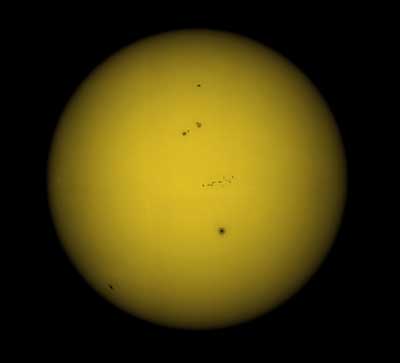 |
White
light band, Full Disk. This was the first attempt to shoot the
new Lunt CaK scope without the calcium filter, and try using
a new Baader Astrosolar safety film front filter. This did not
work too well, the objective lens works fine on the narrow band
calcium, but had bad chromatic abberation on the white light,
and was poor at resolution and crispness. But its my first full
disk shot in years! So this image is a 4x prime focus assembled
in iMerge taken on 10/15
|
 |
This
image was taken the next day and is colorized less for a natural
look, since the sun is pure white by definition anyway. Same
setup.
|
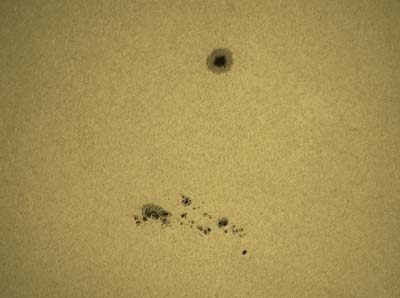 |
Next,
i tried the ETX was tried with much better results! This very
well corrected system has proven itself to be diffraction limited
for a 90mm aperture on doubles at night. This 1250mm f/12.5 system
was used with the DMK camera and an OIII filter to increase contrast
and greatly improve the seeing. AR1314 at top and the extremely
active AR1319 which was constantly flaring in halpha and CaK.
This is my first image ever to show granulation in the background!
|
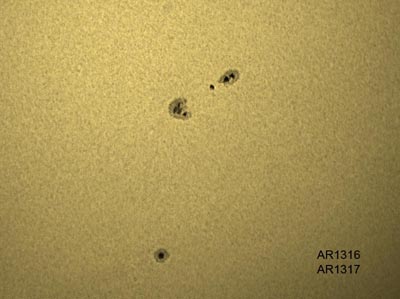 |
Just
south is AR1316 and AR1317. While not particularly active, the
group had some complex umbras.
|
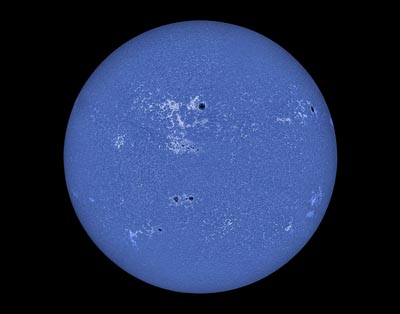 |
Calcium
K image with the Lunt 60mm. This full disk shot was made from
4 parts to avoid the edge vignetting, and shows tremendous faculae
(white clouds) details in the Photospheric Faculae especially
around AR1314.
|
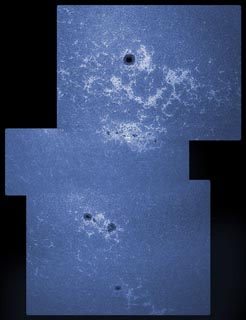 |
Three
part montage with the 2x coronado barlow. The second spot group
down AR1319 is tremendously active, despite its weak appearance
here.
|
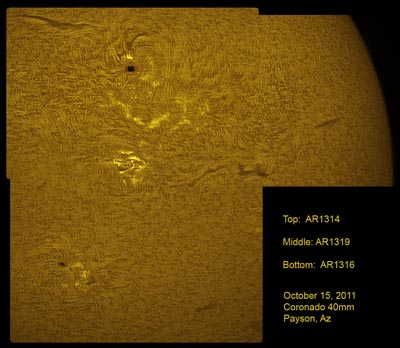 |
Three
part Hydrogen Alpha mosiac with the Coronado 40mm. The Big Three
sunspots can be seen here, and AR1319 can be seen mildly flaring
here in the center. |
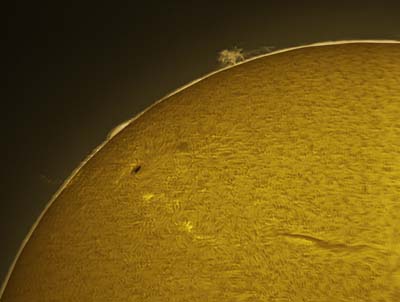 |
Finally,
on the limb we find the solitary sunspot AR1312, and a very nice
tree shaped prominence. Im still experimenting with color schemes
here, You cannot colorize the sun too much or the bright details
will simply dissapear!
|
|

Instrument: Coronado 40mm Halpha or Lunt 60mm CaK Platform: Astrophysics 1200 Camera: DMK 3U (1024x768) Location: Payson, Arizona Elevation: 5150 ft. Sky: Seeing 7/10, Transparency 10/10 Outside Temperature: 75F Processing: Registax 6, Photoshop CS2 Solar Home Page HOME SCHMIDT GALAXIES EMISSION NEBS REFLECTION NEBS COMETS GLOBULARS OPEN CLUST PLANETARIES LINKS







